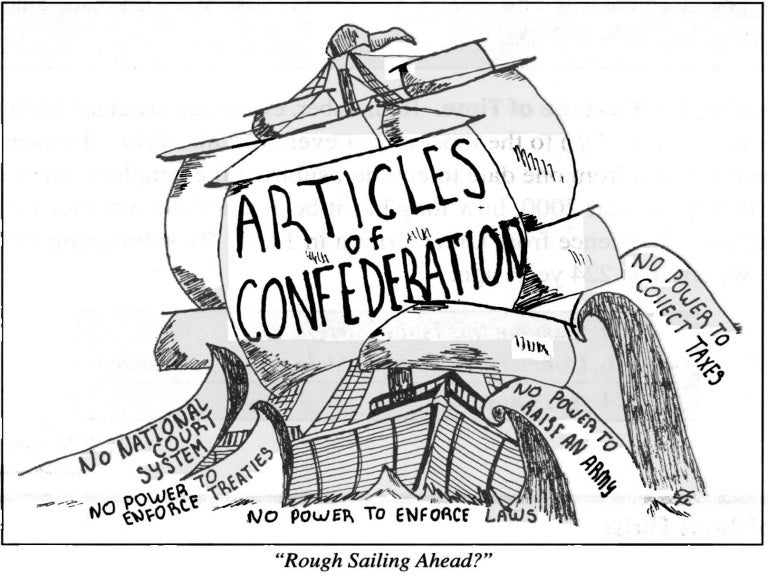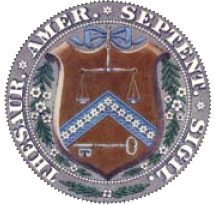
Topics on the Page
Overview of the Articles
- Rationales, Strengths, and Weaknesses
Problems with the Articles
CROSS-LINK: Shays' Rebellion
Slavery and the Articles
 CROSS-LINK: The Articles of Confederation
CROSS-LINK: The Articles of Confederation
Focus Question: What were the reasons for the adoption and failure of the Articles of Confederation?
 |
| Seal of the Treasury of North America, 1782 |
The Articles of Confederation, written in 1781, established a constitution for a permanent United States of America. It was an agreement between the 13 founding states that legally established them as a complete nation. The Articles gave legitimacy to the Continental Congress to direct the rest of the Revolutionary War, which ended in 1783.
Overview
This first version of the United States Constitution gave far too much power to the states, and left almost no power to the central government.
You may find a full transcript of the Articles of Confederation here.
Congress was not able to establish taxes, regulate trade between states, and could not summon armies to defend the country.
There was also no executive branch, nor a judiciary branch. Congress was the only established government body at the national level.
These duties and many others instead rested upon each state's government, and it was up to them to decide how much money they wanted to donate to the federal government.
Why were the Articles made? What were some of its strengths and weaknesses?
 Rationales:
Rationales:
- To protect the freedom and independence of each state.
- To establish a single currency.
- To give a national government the power to make war and to dictate the terms of peace.
Strengths:
- Congress was established officially as the national government body.
- The nation now had the power to make war and peace with other countries.
- The country could borrow money.
- The Articles established a national postal service.
Weaknesses:
- The government lacked the ability to levy and regulate taxes.
- No executive department to enforce laws and no national court system to interpret laws. Instead, there was a "league of friendships" between states.
- Congress could not regulate trade between the US and other countries, nor regulate trade between states.
- The national government could not raise an army itself, and had to rely on the states' armies.
This next link does a fantastic job of describing each Specific Article in the Articles of Confederation.
Problems with the Articles of Confederation
The Articles lacked national unity, and the states acted more like independent mini-nations:
- There was an economic downtown due to the disruptions in trade and farming caused by the war, but the new nation did not have the ability to address these problems. The government had no authority over trade between states, and it was powerless to address the restrictions that Great Britain (the largest naval power in the world at the time) placed on American trade. Great Britain sold manufactured goods at extremely low prices, which undermined the efforts of American producers, but the new American government did not have the ability under the Articles of Confederation to levy tariffs on imports to address this problem.
- The US government did not have the ability to raise money through taxes to pay its debts. The states only gave money to the new national government when it served their specific interests. The paper money issued by the weak national government--"continental dollars"--were viewed as being worthless, and most people preferred to use gold and silver. The wealthy leaders in the country wanted a system whereby they would know that the national government would repay them, and this wasn't certain under the Articles of Confederation. States, dealing with disruptions to their economies by the war, levied high taxes on farmers, and this caused farmers to go into debt and then lose their lands. This, naturally, caused the new country's large agrarian population to grow dissatisfied with the government.
Shays' Rebellion
Shays' Rebellion highlighted the economic problems of the US under the Articles of Confederation.
- Massachusetts taxed its citizens to pay debts, and many poor farmers lost their farms as a result.
- Crowds began to form in front of state court buildings to protest against and to hopefully prevent further foreclosures in the fall of 1786.
- Daniel Shays led protesters in a rebellion against foreclosures.
- Shays and his followers attempted to seize the federal armory in Springfield, Massachusetts in 1786, and again in early 1787. They were stopped by the state militia.
- There was a fear that this rebellion would spread to other states.
- George Washington commented on the weaknesses of the new nation that were highlighted by Shay's Rebellion: "What a triumph for our enemies...to find we are incapable of governing ourselves."
Here is a link to a YouTube video from Pursuit of History, explaining the Articles of Confederation and Shay's Rebellion.
The Articles of Confederation did not directly address the issue of Slavery.
This essay from the Constitutional Rights Foundation explains some of the key issues of the debate around slavery, and why the Articles of Confederation left out any mention of slavery.
- Along with issues such as voting rights, Slavery was wholly left up to states to address (or not address) in their own state constitutions.
- Pennsylvania abolished Slavery in 1780, and many other Northern States soon followed suit.
- In some Southern States, restrictions on the ability of individual slave owners to free their slaves were relaxed in the years before the ratification of the Constitution.
The Articles of Confederation would last until 1788, when the Constitution was ratified.
Bibliography
Souza, Christopher A. Lesson: The New Nation’s Start, Johnston, RI, October 11, 2005.
Souza, Christopher A. Lesson: The New Nation Starts and Expands, Johnston, RI, October 13, 2005.
http://www.apstudynotes.org/us-history/topics/articles-of-confederation/
Comments (0)
You don't have permission to comment on this page.